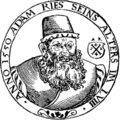Template:Selected anniversaries/March 30: Difference between revisions
No edit summary |
No edit summary |
||
| Line 4: | Line 4: | ||
||1202: Joachim of Fiore dies ... mystic and theologian. No DOB. Pic. | ||1202: Joachim of Fiore dies ... mystic and theologian. No DOB. Pic. | ||
File:Adam Ries.png|link=Adam Ries (nonfiction)|1599: Mathematician [[Adam Ries (nonfiction)|Adam Ries]] dies. | File:Adam Ries.png|link=Adam Ries (nonfiction)|1599: Mathematician [[Adam Ries (nonfiction)|Adam Ries]] dies. Reis wrote textbooks for practical mathematics, promoting the advantages of Arabic/Indian numerals over Roman numerals. | ||
File:Tabulae_motuum_caelestium_universales_by_Vincentio_Reinieri_(1647).png|link=Vincentio Reinieri (nonfiction)|1606: Mathematician and astronomer [[Vincentio Reinieri (nonfiction)|Vincentio Reinieri]] born. Reinieri revised and finished the work of [[Galileo Galilei (nonfiction)|Galileo]], who before his death placed all of the papers containing his observations and calculations in Reinieri's hands. | File:Tabulae_motuum_caelestium_universales_by_Vincentio_Reinieri_(1647).png|link=Vincentio Reinieri (nonfiction)|1606: Mathematician and astronomer [[Vincentio Reinieri (nonfiction)|Vincentio Reinieri]] born. Reinieri revised and finished the work of [[Galileo Galilei (nonfiction)|Galileo]], who before his death placed all of the papers containing his observations and calculations in Reinieri's hands. | ||
| Line 16: | Line 16: | ||
||1783: William Hunter dies ... anatomist and physician ... a leading teacher of anatomy, and the outstanding obstetrician of his day. Pic. | ||1783: William Hunter dies ... anatomist and physician ... a leading teacher of anatomy, and the outstanding obstetrician of his day. Pic. | ||
File:Robert Bunsen.jpg|link=Robert Bunsen (nonfiction)|1811: Chemist and academic [[Robert Bunsen (nonfiction)|Robert Bunsen]] born. | File:Robert Bunsen.jpg|link=Robert Bunsen (nonfiction)|1811: Chemist and academic [[Robert Bunsen (nonfiction)|Robert Bunsen]] born. Bunsen will investigate emission spectra of heated elements, and discover caesium (in 1860) and rubidium (in 1861) with the physicist Gustav Kirchhoff. | ||
||1832: Stephen Groombridge dies ... merchant and astronomer. Pic. | ||1832: Stephen Groombridge dies ... merchant and astronomer. Pic. | ||
| Line 32: | Line 32: | ||
||1867: Alaska is purchased from Russia for $7.2 million, about 2-cent/acre ($4.19/km²), by United States Secretary of State William H. Seward. | ||1867: Alaska is purchased from Russia for $7.2 million, about 2-cent/acre ($4.19/km²), by United States Secretary of State William H. Seward. | ||
File:Stanisław Leśniewski.jpg|link=Stanisław Leśniewski (nonfiction)|1886: Mathematician, philosopher, and logician [[Stanisław Leśniewski (nonfiction)|Stanisław Leśniewski]] born. | File:Stanisław Leśniewski.jpg|link=Stanisław Leśniewski (nonfiction)|1886: Mathematician, philosopher, and logician [[Stanisław Leśniewski (nonfiction)|Stanisław Leśniewski]] born. Leśniewski will posit three nested formal systems, to which he will give the Greek-derived names of protothetic, ontology, and mereology. | ||
||1888: J. R. Williams born ... cartoonist. Pic. | ||1888: J. R. Williams born ... cartoonist. Pic. | ||
| Line 78: | Line 78: | ||
||1982: Space Shuttle program: STS-3 Mission is completed with the landing of Columbia at White Sands Missile Range, New Mexico. | ||1982: Space Shuttle program: STS-3 Mission is completed with the landing of Columbia at White Sands Missile Range, New Mexico. | ||
File:John_Lighton_Synge.jpg|link=John Lighton Synge (nonfiction)|1995: Mathematician, physicist, and academic [[John Lighton Synge (nonfiction)|John Lighton Synge]] dies. | File:John_Lighton_Synge.jpg|link=John Lighton Synge (nonfiction)|1995: Mathematician, physicist, and academic [[John Lighton Synge (nonfiction)|John Lighton Synge]] dies. Synge was a prolific author and influential mentor, and is credited with the introduction of a new geometrical approach to the theory of relativity. | ||
File:Harold Scott MacDonald Coxeter.jpg|link=Harold Scott MacDonald Coxeter (nonfiction)|1996: Mathematician and crime-fighter [[Harold Scott MacDonald Coxeter (nonfiction)|Harold Scott MacDonald Coxeter]] uses his [[Coxeter's loxodromic sequence of tangent circles (nonfiction)|loxodromic sequence of tangent circles]] to detect and prevent [[crimes against mathematical constants]]. | File:Harold Scott MacDonald Coxeter.jpg|link=Harold Scott MacDonald Coxeter (nonfiction)|1996: Mathematician and crime-fighter [[Harold Scott MacDonald Coxeter (nonfiction)|Harold Scott MacDonald Coxeter]] uses his [[Coxeter's loxodromic sequence of tangent circles (nonfiction)|loxodromic sequence of tangent circles]] to detect and prevent [[crimes against mathematical constants]]. | ||
Revision as of 06:45, 31 March 2020
1599: Mathematician Adam Ries dies. Reis wrote textbooks for practical mathematics, promoting the advantages of Arabic/Indian numerals over Roman numerals.
1606: Mathematician and astronomer Vincentio Reinieri born. Reinieri revised and finished the work of Galileo, who before his death placed all of the papers containing his observations and calculations in Reinieri's hands.
1811: Chemist and academic Robert Bunsen born. Bunsen will investigate emission spectra of heated elements, and discover caesium (in 1860) and rubidium (in 1861) with the physicist Gustav Kirchhoff.
1862: Mathematician, philosopher, and crime-fighter Antoine Augustin Cournot uses the ideas of functions and probability to locate and apprehend math criminals.
1886: Mathematician, philosopher, and logician Stanisław Leśniewski born. Leśniewski will posit three nested formal systems, to which he will give the Greek-derived names of protothetic, ontology, and mereology.
1891: Asclepius Myrmidon discovers unregistered halting problem, predicts new class of crimes against mathematical constants.
1892: Mathematician and academic Stefan Banach born. Banach will be one of the founders of modern functional analysis.
1944: Physicist Charles Vernon Boys dies. Boys achieved recognition as a scientist for his invention of the fused quartz fibre torsion balance, which allowed him to measure extremely small forces, and is remembered for his careful and innovative experimental work.
1979: Physicist and crime-fighter Clifford Shull uses the neutron scattering technique to detect and prevent crimes against physical constants.
1995: Mathematician, physicist, and academic John Lighton Synge dies. Synge was a prolific author and influential mentor, and is credited with the introduction of a new geometrical approach to the theory of relativity.
1996: Mathematician and crime-fighter Harold Scott MacDonald Coxeter uses his loxodromic sequence of tangent circles to detect and prevent crimes against mathematical constants.
2018: Math photographer Cantor Parabola attends Minicon 53, taking a series of photographs with temporal superimpositions from Minicons 52 and 54.











